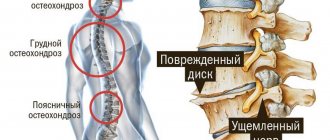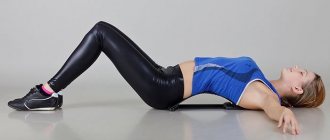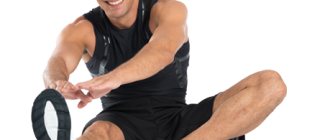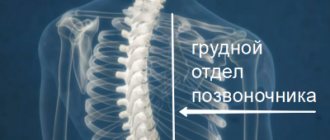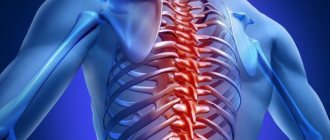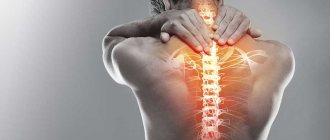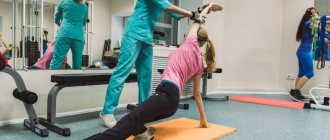Osteochondrosis is a serious degenerative-dystrophic process that occurs in the intervertebral discs. It can occur in any part of the spine, but is most often diagnosed in the neck area, since it is the most mobile. In the absence of adequate treatment, the disease leads to serious consequences. Therefore, you should contact a specialist when the first signs of violations appear. Exercises for osteochondrosis are an integral part of therapy aimed at restoring normal nutrition to the damaged area.
Indications for exercise therapy
Gymnastics for osteochondrosis of the cervicothoracic region is not always prescribed, only if there are indications. Otherwise, it will cause the condition to worsen. The main ones are:
- Atrophic and dystrophic changes in tissues.
- Remission stage for continuous treatment of osteochondrosis.
- Enhancing the effect of a number of pharmaceutical drugs.
- Secondary assistance and improvement of the effect of physiotherapeutic procedures.
- Increasing blood flow and lymph flow to speed up metabolic processes in the body.
- Prevention of diseases associated with a sedentary lifestyle, or developing as a complication of osteochondrosis.
Therapeutic gymnastics is not used during an exacerbation, in the presence of diseases of the cardiovascular systems, neurological disorders, mental disorders, or oncological formations in the body. There are other contraindications to the prescription of therapeutic exercises, which are taken into account when the doctor collects an anamnesis.
Main tasks of exercise therapy
Osteochondrosis of the cervicothoracic spine manifests itself with severe symptoms. Patients complain of muscle stiffness, pain, and limited body mobility. But regular exercises can relieve discomfort and restore normal blood circulation in the affected area. The main objectives of therapeutic gymnastics are:
- Relaxation of muscles and normalization of blood circulation in soft tissues.
- Gradually increase the patient's physical activity.
- Elimination of physical inactivity.
- Strengthening the muscular frame of the back.
- Elimination of stagnant processes in blood vessels.
- Release of nerve roots.
- Improving metabolic processes in soft tissues.
- Normalization of the tone of the central nervous system.
Exercises for cervicothoracic osteochondrosis are aimed at eliminating excess load on the spine. Therefore, they are the basis of any prescribed therapy. After surgery, they help the patient adapt to normal activities.
No ads 1
What is thoracic osteochondrosis?
Changes in metabolic processes and excessive loads on the discs cause the development of thoracic osteochondrosis. The structure of the intervertebral disc is disrupted . The nucleus pulposus dries out and its shock-absorbing property is lost.
Osteochondrosis primarily affects the intervertebral disc, as a result of which it becomes thinner
In addition, the fibrous ring becomes thinner, which begins to crack. The result of this process is pinching of the spinal cord nerve roots. They become inflamed, causing severe pain. With osteochondrosis of the thoracic region, not only the discs are destroyed, but also the ligaments and joints of the spine.
Rules for performing exercises
Exercise therapy for cervicothoracic osteochondrosis requires compliance with a number of simple rules. Constantly repeated exercises stimulate muscle function, thereby improving its condition and eliminating the cause of damage to discs and vertebrae. The process requires load control, so the first classes are conducted under the supervision of a medical professional. The lesson is conducted in compliance with the following principles:
Gymnastics for the cervical spine by Dr. Shishonin
- The training takes place in a clean, open, well-ventilated room.
- Any sudden movements or turns that could aggravate unpleasant symptoms are prohibited.
- The set of exercises should be as simple as possible so that a person with any level of physical fitness can perform it.
- If unpleasant sensations appear during the process, stop the activity; in case of acute pain, consult a doctor.
- The load should increase gradually so that the body can get used to it.
- All exercises that cause discomfort are completely excluded from the complex.
- Charging should be done every day at the same time for better results.
- While doing this, you should breathe through your nose.
It should also be remembered that at least one hour must pass before the start of gymnastics and the last meal. Between each exercise you should take a short break to restore your breathing.
General exercises
The physical therapy complex consists of exercises selected individually for each patient. But regardless of the form of the disease and the degree of progression, there are basic approaches that are useful to all patients with cervical osteochondrosis. These include:
- Stand up straight. In turn, lift each shoulder up, trying to reach your ear. It is enough to perform 10 times for each hand.
- Sit up straight, arms hanging along your body. Turn your head to the left, hold for 10 seconds, and return to the starting position. Repeat the action on the other side.
- Bend your head, trying to counteract the movement with the hand opposite the side to which you are tilting.
- Stand straight, feet shoulder-width apart. Fix your palms in the shoulder area. We make circular movements with our elbows in each direction in turn.
- Stand up straight, place your palms near your shoulder blades, and bend forward. Stay in this position for 10 seconds, then return to the starting position.
- Straighten your shoulders, legs slightly apart. Raise your knee, trying to reach it with your shoulder, the body leans forward a little.
Exercises for cervical chondrosis can be performed in the gym or at home, depending on the stage of development of the disease. Despite the simplicity of the actions, they are all aimed at strengthening the muscle frame and helping to quickly achieve stable remission.
One example of an effective complex of therapeutic exercises
Description of the problem
- The disease begins with dehydration of the nuclei of the intervertebral discs; as a result, the nuclei become flattened, the vertebrae move closer together, and the spinal column itself “settles.”
- At the next stage of the disease, spondylolisthesis occurs - displacement of the cervical vertebrae, ligaments and muscles change their position. Neck mobility is limited and pain appears.
- The third stage of cervical osteochondrosis is characterized by the appearance of intervertebral protrusions (hernias) and the occurrence of arthrosis.
- At the fourth stage of cervical osteochondrosis, osteophytes appear - bone growths, with the help of which the body tries to compensate for the lost support function. The spine is practically immobilized.
Special exercises
Treatment of pathological processes occurring in the vertebrae is a labor-intensive process. To speed up and increase efficiency in the process of performing exercises, special devices are used, for example, a gymnastic stick. With it you can significantly diversify your exercises, performing workouts both at home and in the gym.
When working with the neck, a gymnastic stick allows you to relax the muscle frame as much as possible, effectively work out all problem areas, and increase blood flow. You can even use it for preventive purposes. The complex using this device includes the following approaches:
- Stand straight, feet shoulder-width apart. Grab both ends of the stick with your hands and pull them forward. Gradually make rotational movements without bending your elbows. It is better to increase the amplitude gradually. It is enough to make 10 movements in each direction.
- Without changing your position, after a short break, raise the stick in front of you, placing it in a horizontal position, and then change it to a vertical one. Repeat the action several times.
- Raise the gymnastic stick high up and take a full breath, and as you exhale, lower it down. The exercise is aimed at stabilizing breathing.
- Take a gymnastic stick and lift it up. As you inhale, bend your lower back, and as you exhale, return to the starting position. Repeat the exercise 7-10 times.
Gymnastics requires certain preparation, so all movements are performed carefully to eliminate the possibility of injury. Otherwise, you can cause damage to the ridge.
Popular techniques
Therapeutic gymnastics for cervical and thoracic osteochondrosis involves choosing techniques developed by doctors to achieve the desired therapeutic result. The author's programs are adapted to specific diseases, helping to effectively recover and restore the health of the spine. The most popular of them are the methods of Bubnovsky, Dikul, Shishonin. Each has its own advantages and disadvantages and helps achieve certain results.
No ads 2
Bubnovsky's technique
The most popular and frequently used program, with a minimum number of contraindications and easy to use. The exercises do not require the use of special equipment and are suitable for people with different levels of physical fitness. The program is conducted both at home and in the gym. The complex includes the following approaches:
- Stand up straight, place your hand behind your head, tilt your head, offering resistance with your limb. Repeat 3-5 times.
- Perform head tilts in different directions. Repeat 5-7 times.
- Sit straight on a chair, fix the position with your hands, holding the back. The upper part of the body is arched at a maximum angle. It is enough to complete 5-7 approaches.
- Sit on the floor, clasp your knees with your hands. Gradually lower yourself onto your back and return to the starting position. Perform 5-6 approaches.
The first course is carried out under the supervision of a specialist, the second and subsequent courses can be completed independently at home. The technique allows you to get excellent results, since motor activity is restored by 50-70%. As physical fitness improves, the use of gymnastic equipment is allowed.
[node:field_similarlink]
Shishonin program
The technique is based on a combination of physical exercises and deep breathing practices. Its implementation is permissible in any conditions, as it is not difficult. Examples of exercises:
- Bends to the sides (left and right) are performed as a warm-up. They are performed continuously, like a pendulum. It is enough to complete 10-15 approaches.
- Sit up straight, tilt your head forward, touching your chin to your chest. Repeat 7-10 times.
- Fix your body, slowly turn your head, touch your chin to your shoulder. Number of approaches – 6-8 times.
- At the same time, the head bends forward along with the shoulders, after which they straighten as they exhale. 15 movements are made in both directions.
The program is suitable for all patients, regardless of physical fitness. It is recommended to carry out training 2 times a day for 20 minutes until a pronounced therapeutic effect is obtained.
Dikul's technique
The Dikul technique is used for cervical and thoracic osteochondrosis to eliminate muscle tissue atrophy, and restore health after surgery, in advanced stages of the disease. Thanks to the thoughtfulness of the program, it can easily replace manual therapy. The following exercises are usually used:
- Get on all fours, focusing on your palms and knees. Gradually bend and straighten the cervical and thoracic spine. 10 approaches are enough, without long pauses.
- Reclining, bend your knees, legs under your body, stomach touching your limbs. Extend your arms and upper body forward. At the stage of maximum extension, bend and straighten 3-4 times.
- Sit on the floor, tilt your body to the right, then to the left. The neck and chest should be included as much as possible in the process. It is enough to do 5-7 repetitions.
Dikul’s program is not much different from others, but it is the simplicity of the approaches and dosed exercise that allows patients to effectively recover after surgical interventions and eliminate the manifestations of osteochondrosis.
A good complex instead of morning exercises
No ads 3
Norbekov system
Representative of alternative medicine Norbekov M.S. developed a technique that activates the body's internal resources. The process requires self-control and a complete revision of your attitude towards the world around you. The program consists of exercises aimed at improving the condition of joints, normalizing the circulatory system and central nervous system, and regulating the internal psycho-emotional state. The complex includes the following exercises:
- Stand up straight, tilt your head back, chin up. Stay in this position, and then repeat the approach.
- The back is straight, the shoulders are straightened and motionless. The head leans forward and, without unnecessary tension or pressure, moves towards the shoulder, trying to touch it with the ear. A similar movement is repeated for the other side.
- Slowly roll your head from side to side, controlling your breathing and internal sensations. If physical fitness does not allow, you can not perform a full circle.
It is not recommended to practice the system for pregnant women suffering from epileptic seizures, having had a heart attack, or during periods of mental instability. During classes, it is also recommended to practice self-hypnosis and meditation to enhance the effect obtained.
Exercises with a gymnastic stick for certain diseases
httpv://www.youtube.com/watch?v=embed/_S7yd8diu2s
There is a set of tasks with a projectile for osteochondrosis
When choosing a set of such exercises, it is important to take into account age and physical fitness. Exercises for the purpose of therapeutic therapy should not be performed with overexertion, otherwise the therapeutic effect will be reduced. It is important to control your condition and sensations during training.
Standard set of exercises for osteochondrosis:
- The object rises above itself, then moves to a position in front of itself and falls down.
- The stick in your hands is placed behind your head, your hands must be lowered as low as possible to the lower back. The projectile should be raised as high as possible behind your back, moving your arms further away from the body. Next, bend forward, while retracting the abdominal muscles.
- Crossing your arms with a projectile in your hands. Tension should appear between the shoulder blades. Slowly straightens the right arm to the side. The exercise is repeated with the left hand.
Recommendations for performing the complex for osteochondrosis:
It is recommended to exercise daily. The execution time is any, the only requirement is to complete it no later than a few hours before bedtime
It is important to monitor your breathing during exercise. If your health is favorable, it is recommended to gradually increase the load
If there is discomfort and pain when performing a certain task, it should be excluded from the complex or replaced with another similar one. During exercise, it is recommended to regularly measure your pulse, avoiding its excessive increase.
Exercises using a gymnastic stick help in the treatment of flat feet.
httpv://www.youtube.com/watch?v=embed/-tWwRAia3cs
A set of exercises for treating flat feet:
- Rolling an object with your feet. The exercise is performed standing or sitting, the stick rolls over the surface. Next, the exercise is repeated with both legs simultaneously. The duration of the task is 10 minutes.
- Walking across. The object is placed across the foot, in its middle. This is how the steps are completed. This exercise is most effective in treating transverse flat feet.
- Walking along a stick. The stick is positioned parallel to the feet, lengthwise. Steps are taken forward with your toes, then starting with your heels. This exercise is most effective in the treatment of longitudinal flat feet.
What are the benefits of exercise?
All physical The exercises included in the complex of therapeutic exercises are aimed at enhancing the effect of drugs and physiotherapy sessions. When performed regularly, the benefits for the body are as follows:
- Any congestion in the joints is eliminated.
- The pain weakens and gradually disappears altogether.
- The range of movements in the neck and thoracic region increases.
- Reducing the load on the spine and improving well-being.
- Restoration of cartilage tissue due to increased blood circulation.
- Strengthening the muscle corset and supporting the spine in the correct position.
Before performing physical exercises, you should make sure that it is advisable to use exercise therapy. After all, they cannot always eliminate unpleasant sensations, but on the contrary, intensify them and create additional tension in the affected area.
Gymnastics with a properly selected set of exercises is an integral part of the treatment of osteochondrosis. It allows you to restore the anatomically correct position of the spine, restore normal mobility of the vertebrae, improve the condition of bone and connective tissue, and reduce the likelihood of acute pain syndrome. In the process, it is important to follow the execution technique and basic rules.
Traditional treatment
Therapy for thoracic osteochondrosis is carried out in several ways, based on indications:
- Conservative treatment.
- Traction.
- Surgical intervention.
The most commonly used drugs are medications . The basic principles of such therapy:
- Pain relief - glucocorticosteroids and anti-inflammatory drugs.
- Improvement of cartilage tissue - chondoprotectors (Alflutop).
- Preservation of fluid in the disc - Papain.
- Reduce muscle spasms - muscle relaxants.
If a hernia occurs, surgery is often required. But it is prescribed only after differential diagnosis in order to exclude similar pathologies.
Additional methods are also used:
- Physiotherapy - electrophoresis, magnetotherapy, ultraviolet exposure.
- Acupuncture.
- Massage.
- Physiotherapy.
Without physical exercise, treatment will be pointless, but only a doctor should formulate complexes.
